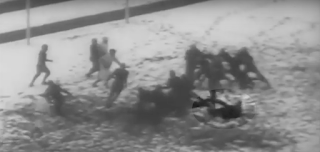I recently watched the first episode of Alex Trebek’s Jeopardy! from 1984. As I’m watching the first three contestants walking on stage, making TV history, all I could think was, “I’ll bet no one believed these three whenever they told their friends they were on the first episode of a TV institution.”
Which brings us to another story of a “sideline” athlete, following Yale’s student manager-turned-football player. On Nov. 23, 1935, Princeton defeated Dartmouth, 26-6, in a battle of undefeated teams at Palmer Stadium — with no help from a fan who ran onto the field who tried in vain to help the Big Green’s cause.
And while the culprit was never identified, any number of people for years afterward probably claimed to be what came to be known as the “12th man game.” (All apologies to Texas A&M and the Seattle Seahawks.)
 |
| The 1935 Princeton Tigers ... |
 |
| ... and the '35 Dartmouth Big Green. Only the lettermen are showed here, so the fan who tried to help out the Green didn't play enough to earn a letter, apparently. |
A crowd of 55,000 filled the stadium despite a snowstorm and watched Princeton score four straight touchdowns after Dartmouth took an early 6-0 lead. Up 19-6 or 20-6 in the fourth quarter, depending on your source, the Tigers drove down to the Dartmouth 2- or 3-yard line, again, depending on your source. On third down, a fan leaped out of the end zone stands and lined up between two Dartmouth linemen, shouting “Kill them Princeton bastards!” as the Tigers center snapped the ball. The fan lunged at Princeton ballcarrier Pepper Constable … and fell flat on his face as Constable advanced just short of the goal line. After the cops hauled the guy away, Princeton scored on fourth down to account for the final score.
 |
| From a YouTube video of the "12th man game": First, an inebriated fan runs onto the field as Princeton snaps the ball ... |
 |
| ... Next, the poor schmuck is shoved on his derriere ... |
 |
| ... Then hauled away by the cops as he gives the "We're No. 1" sign ... (or maybe "only one more shot for me today!") |
 |
| ... and is stopped from slipping in the snow, puking his guts out or both. |
As this Sports Illustrated story, er, illustrates, a number of people claimed to be the Big Green’s 12th man, including a short-order cook and an architect, neither of whom were Princeton fans. Whomever it was, not everyone was happy to see him go. “I was truly sorry to see him leave,” Dartmouth tackle Dave Camerer told SI in 1962. “The way they were ripping through us we needed all the help we could get.”
Added Camerer, in John McCallum’s “Ivy League Football Since 1872”: “I don’t think he was a college man. At least, what he yelled was, ‘Kill them Princeton bastards.’ ”
And hey, you can see the incident for yourself right here! (The fan, whoever he was, falls flat on his arse at about the 24-second mark.)
——
Now onto the uniforms. I would have sworn up, down and around that I wrote about the 1930s Tigers before, but apparently, I have not. This was the year Princeton coach Fritz Crisler introduced the iconic winged helmet, with the orange front and orange stripes down the black shell. After going 35-9-5 at Princeton from 1932-37, Crisler took his coaching talents — and the winged helmet — to Michigan, where he went 71-16-3 from 1938-47.
Princeton wasn’t the first school to wear such a design — my research has New Hampshire wearing something similar as early as 1933, and this site says Ohio State started wearing a winged design in 1930 — but Crisler and the Tigers made it nationally popular, since the New York Times probably wasn't covering UNH games then. A couple of Michigan men, Dave Nelson and Harold Westerman, brought the design to Maine in 1949 (Nelson was head coach, Westerman his assistant), and Nelson brought it to Delaware as head coach in 1951; the Blue Hens wear it to this day.
 |
| Some Princeton equipment guys brandishing bushels of helmets in 1937. Oh, to go back in time and grab one or two helmets ... |
Princeton eventually went to plain orange helmets, but resurrected the winged look in 1998 (good) and reversed the colors in 2012 (not good).
The ’35 Tigers finished 9-0-0, and TipTop 25’s retroactive rankings has them at No. 4 for the season, who sounds about right. (While Princeton went undefeated, its schedule was a string of cream puffs. When Williams is judged one of your better opponents, that’s not a good sign.)
 |
| That's Fritz Crisler directing the Princeton Tigers in 1937. If you look closely, you can see he's coaching IN FULL UNIFORM. Now that's a badass. |
***
I wrote (OK, it’s more like a drive-by) about Dartmouth’s mid-30s unis here. TipTop puts the Big Green, who finished 8-2, in the “others receiving votes” category. A few other notes about this team, for those of you still reading: 😎
- This was the Dartmouth team that made history when it defeated Yale 14-6 at the Yale Bowl to end the so-called “Yale Jinx,” an 0-16-2 stretch against the Bulldogs dating back to 1884 (Dartmouth lost a 113-0 nail-biter).
- The coach was Earl “Red” Blaik, who ran up a 45-15-4 record at Dartmouth from 1934-40 before leaving for Army, where he went 121-33-10 and won three straight national titles from 1944-46 and became one of the most legendary coaches in history.













